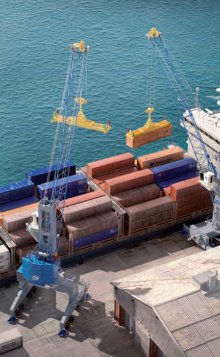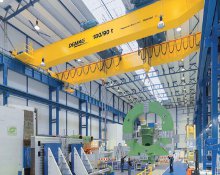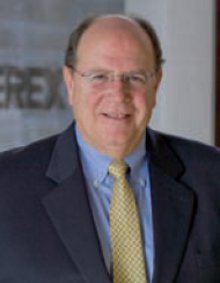Our Story… Terex Corporation
10 May 2013Every issue Hoist tells the history of a company helping to shape the industry. We delve into the company’s past, charting its development since those early, formative years and we attempt to explain how the organization has grown and evolved. This is our history. This is Our Story.
Terex focuses on offering equipment across a range of niche construction and lifting related sectors. Over the past two years, the company has integrated a range of port and factory lifting equipment manufacturers into a new segment, Material Handling & Port Solutions. Here we look at the history of the company, and how it came to be one of the world's biggest manufacturers in the factory crane sector.
The history of Terex is not a simple one. This is the story that led to the name "Terex" and the evolution that followed. However, there is an equally rich history to many of the "historic" names that Terex acquired in recent years.
1933 to 1970
In 1933, what was to eventually become Terex Corporation began its existence as the "Euclid Company," founded by the Armington brothers. Its success designing and building haul trucks later attracted the attention of General Motors, which purchased Euclid in 1953. GM's "Euclid Division" developed and sold large equipment including over half the nation's off-highway dump trucks.
The dominant performance of Euclid had a negative consequence, however, when the US Department of Justice brought an antitrust suit against GM, forcing it to stop manufacturing and selling off-highway trucks in the US for four years, and to divest parts of its Euclid business and the Euclid brand name.
GM coined the "Terex" name in 1970 from the Latin words "terra" (earth) and "rex" (king) for its construction equipment products and trucks not covered by the ruling. The remaining parts of the new Terex business produced crawlers, frontend loaders, and scrapers.
1970s Throughout its maturation, GM's Terex Division created some of the industry's most notable heavy construction equipment, including the world's first offroad hauler (1Z Trac-Truk), the world's first twin-powered dozer (TC-12) and the world's largest truck, the Terex 33-19 "Titan," produced in the 1970s.
The single Titan prototype produced was in service until 1990 and is now on display in Sparwood, British Columbia, near the mine it served. It remains the world's largest truck by dimensions, but not by carrying capacity (370 tons).
1980s
The recession of the early 1980s took its toll on Terex, and General Motors sold Terex to IBH Holdings, a company owned by German businessman, Dieter Esch, in 1981.
IBH Holdings collapsed in a global recession and declared bankruptcy in 1983. Ownership of Terex reverted back to General Motors, who organized it as:
- Terex Equipment Limited (TEL), a manufacturing subsidy located in Scotland
- Terex USA, a distributor for Terex products in the Western Hemisphere and a manufacturer of equipment and parts at its factory in Hudson, Ohio.
In 1986, Northwest Engineering, a company purchased by American entrepreneur Randolph Lenz in the early 1980's, acquired Terex USA out of bankruptcy. At the time, Northwest Engineering was headquartered in Green Bay, Wisconsin.
When Northwest Engineering bought Terex USA in 1986, the agreement included an option to purchase Terex Equipment Limited. Northwest Engineering exercised that option in 1987. During that same year, Lenz expanded the company's manufacturing footprint into Scotland. The next year, the name of the company was changed to Terex Corporation. During the remainder of the decade, Terex made a number of acquisitions, significantly increasing its size and product offerings.
1990-1995
In 1991, Terex was listed on the New York Stock Exchange.
Woody Baldus, CEO, passed away in the fall of 1991. Randolph Lenz assumed the title of Chairman and CEO. This led to the recruitment of Ron DeFeo in May 1992.
Ron DeFeo joined Terex as President of the company's Heavy Equipment Group in Tulsa, Oklahoma.
In 1993, Terex corporate offices were relocated to Westport Connecticut. Then, in October 1993, Ron DeFeo was appointed president and COO of Terex and a member of the Terex board of directors.
Facing a recessionary environment, DeFeo began an aggressive operational and financial restructuring of Terex that included raising additional capital, selling assets, and restructuring operations. Among the actions taken by Terex was a focused effort on turning around Clark Material Handling and the sale of its Fruehauf stock in the private market for $28 million.
Terex acquired PPM in 1995 and combined it with earlier acquisitions, solidifying Terex as a leading manufacturer and distributor of cranes.
Randolph Lenz retired from Terex in 1995 and Ron DeFeo became CEO of Terex.
1996-1999
In 1998, Terex grew its mining business with the acquisitions of Payhauler and O&K Mining. The crane offering also grew dramatically with the acquisitions of American Crane, TerexLift, Peiner and Gru Comedil.
Ron DeFeo was named chairman of the board.
2000 and 2001
In 2000, Terex moved into the compact equipment category with the acquisition of Fermec, a UK manufacturer of tractor loader backhoes.
In 2001, Terex established the Roadbuilding segment with the acquisitions of Jaques (crushing and screening), CMI (road building) and Bid-Well. The company's acquisition of Atlas loader cranes and excavators was also completed this year.
2002
2002 was a significant year for Terex as it acquired several companies-some large, some small.
- Demag Mobile Cranes (manufacturer of telescopic and lattice boom cranes) filled out the Terex Cranes product offering and makes Terex a leading crane company
- Terex purchased Genie, a leading manufacturer of Aerial Work Platforms
The Genie acquisition was also significant because it introduced Terex to the Toyota Production System management philosophy. Genie had incorporated aspects of this philosophy into its business operations with great success. Terex realized the opportunity to apply these practices to all its business. This led to the establishment of the Terex Business System, or TBS.
- The acquisitions of German manufacturers Schaeff and Fuchs enhanced the European construction business.
- Advance Mixer puts Terex in the concrete mixer business
- Finally, the acquisitions of Pacific Utility and EPAC provide company-owned distribution for Terex Utilities.
2006 to 2010
Terex enjoyed success in 2006 and 2007, with growth in developing markets doubling.
In 2007, Terex was ranked as the Number 4 best performing company on the 2007 Barron's 500 survey and #314 on the Fortune 500 list.
Tatra was divested during that year.
In early 2008, Terex acquired ASV, a producer of compact track loaders.
The corporation's set of six core values - The Terex Way - was officially introduced in 2008 at the annual global leadership conference.
The global recession of 2008 hit Terex hard, with many markets seeing declines. Terex placed an increased focus on cash management and managing inventory levels during these uncertain times.
In 2009, Terex acquired the port equipment businesses of Fantuzzi and Noell, now part of the material handling and port solutions segment.
2011
GAZ Group and Terex entered into agreement to form a joint venture company for the manufacture, marketing and sale of construction and roadbuilding equipment in Russia, and the distribution of certain products manufactured by Terex and exported into Russia. The venture would also sell certain construction and road buliding products of GAZ Group for export.
In August 2011, Terex completed the purchase of 82% of the shares of Demag Cranes AG. Combining Demag Cranes AG's Gottwald mobile harbour cranes, Demag-branded industrial lifting equipment, PPM reachstackers and Fantuzzi-Noell port equipment, Terex added a new business segment, to its business, Material Handling & Port Solutions.
2012
In April 2012 the Domination and Profit and Loss Transfer Agreement (DPLA) between Terex and Demag Cranes became effective, paving the way for Terex to fully integrate Demag as a fifth segment of Terex.


